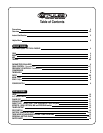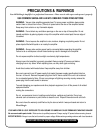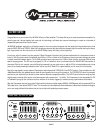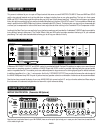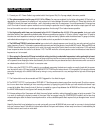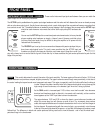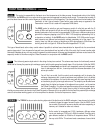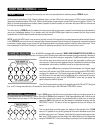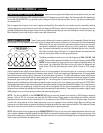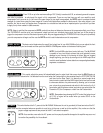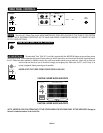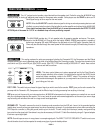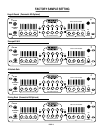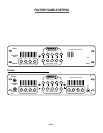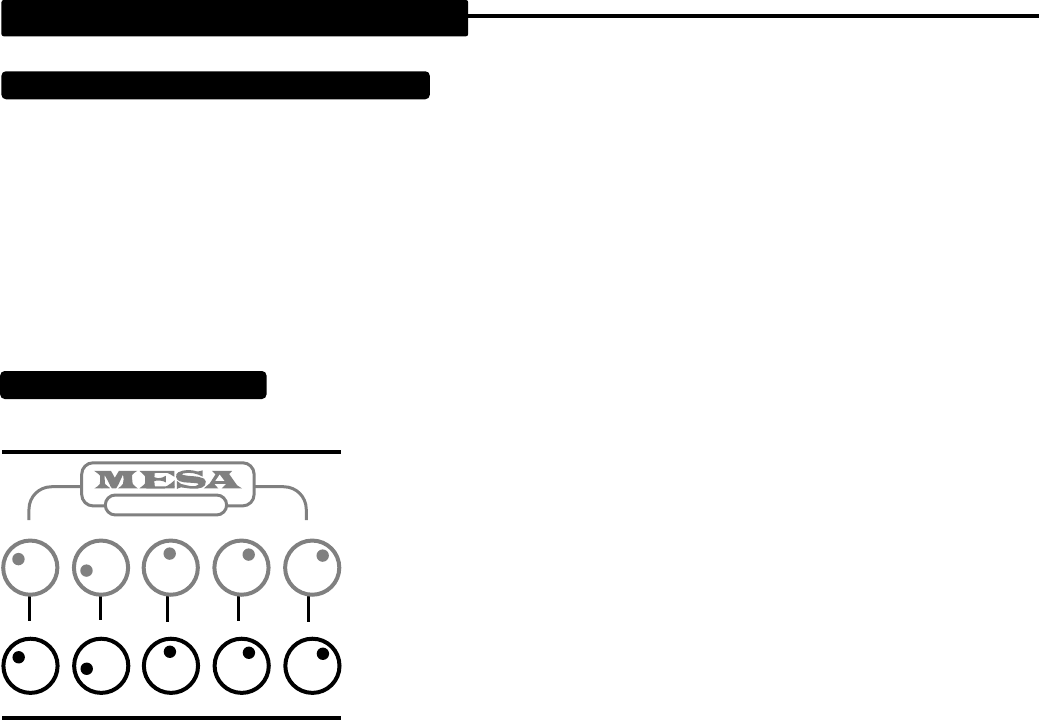
FRONT PANEL CONTROLS: (Continued)
GAIN CONTROLS: Parametric EQ Continued
expect to have a great sound. Make small moves and then allow your ears
time to adjust to the difference. With controls this powerful, EQ Hangover is a part of the buzz. Don’t be surprised if after tweaking for
an hour with the PARAMETRIC, you go back to your starting point and think the amp is broken...it’s not...your ears are suffering from
an overdose of EQ.
May we suggest the old saying “less is more” applies here beautifully. More often than not, a better sound is achieved by notching
(cutting) frequencies you don’t want so much of with the respective GAIN control, rather than boosting them. In this way your ears can
evaluate the differences better and get a bead on the next adjustment because you are not escalating the volume level as you go.
More importantly, you are less likely to create a sound with excess noise.
FREQUENCY CONTROLS:
These 5 rotary controls divide up the frequency spectrum into five sweepable Q bands that allow
you to center-in on any frequency within each of the five ranges with accuracy and then cut or boost each with the accompanying
GAIN control. As you may have noticed, the bands overlap so that you can use adja-
cent bands to manipulate frequencies that are very close to each other, frequency-
wise. For ease of understanding, you can think of the bands like this; Lows, Low-Mid,
Mid, Highs and Super Highs (harmonics). This type of division can sometimes help
when you are trying to identify and dial up sounds quickly.
The Bands are labeled in order from low to high frequecy as 40Hz, 120, 400, 1.4K
and 6K. These numbers represent the Bands’ center Q point frequency and the FRE-
QUENCY control sweeps the range from the two numbers at opposing ends of the
control range. For example the 40Hz Band can be set to focus on frequencies be-
tween 30 and 100Hz with 40Hz being the control Center Q found at 12:00 (straight
up).
Certain frequencies are heard by the ear differently and it is a fair assumption to say that the majority of us are much more sensitive
to midrange and lower-treble frequencies, while we are more “tolerant” of sub-low, low and super high frequencies. You have probably
heard the soundman at many a gig say “take some 1K out of that snare or guitar mic”. This high-mid frequency is often called the
pain
zone
because we are extremely sensitive to these frequencies. Conversely you may have experienced someone (especially veteran
house sound guys) cranking the super high frequencies 3K - 12K causing pain in others who are more sensitive to these regions.
Because we all hear differently and this frequency specific sensitivity exists in all of us to a degree, it is normal for some FREQUENCY
settings within the bands to seem much more powerful and others weaker for the same relevant GAIN setting. This is normal and no,
your
M-PULSE
is not misbehaving. Usually the lowest (40Hz) and highest (6K) are the most susceptible to this - with the most
extreme low and extreme high settings on the two controls showcasing this phenomenon. These settings may require a slightly higher
GAIN setting than you are use to seeing to achieve the desired shaping result.
NOTE:
The two high BANDS of the PARAMETRIC EQ may be extremely powerful and sensitive to GAIN settings, especially
between 1.4K and 12K. For this reason use care with the GAIN controls in these ranges as high settings will produce unwanted
background noise in the form of hiss or white noise. This is made worse if the TREBLE control is set in its higher range. If you need
a sound with a large amount of these Treble frequencies in your mix, approach it from a different angle. Begin by notching lower
frequencies in the other bands, as opposed to boosting the higher bands with the lower bands set more flat. This scheme will greatly
improve the noise floor and still allow you to achieve the desired boost in higher frequencies.
NOTE:
May we again humbly suggest using the PARAMETRIC EQ to fine-tune your sound with subtle adjustments. Much like a car
with an engine capable of ridiculous speeds, the
M-PULSE
incorporates this shaping device capable of ruining a great tone in the
hands of the unwary driver. Use this powerful tool with taste and music in mind and avoid settings that are so extreme that they blow
holes in what could otherwise be a great sound.
PAGE 7
0 db 0 0 0 0
40 Hz 120 400 1.4K 6K
S E M I - P A R A M E T R I C E Q U A L I Z E R
E N G I N E E R I N G



